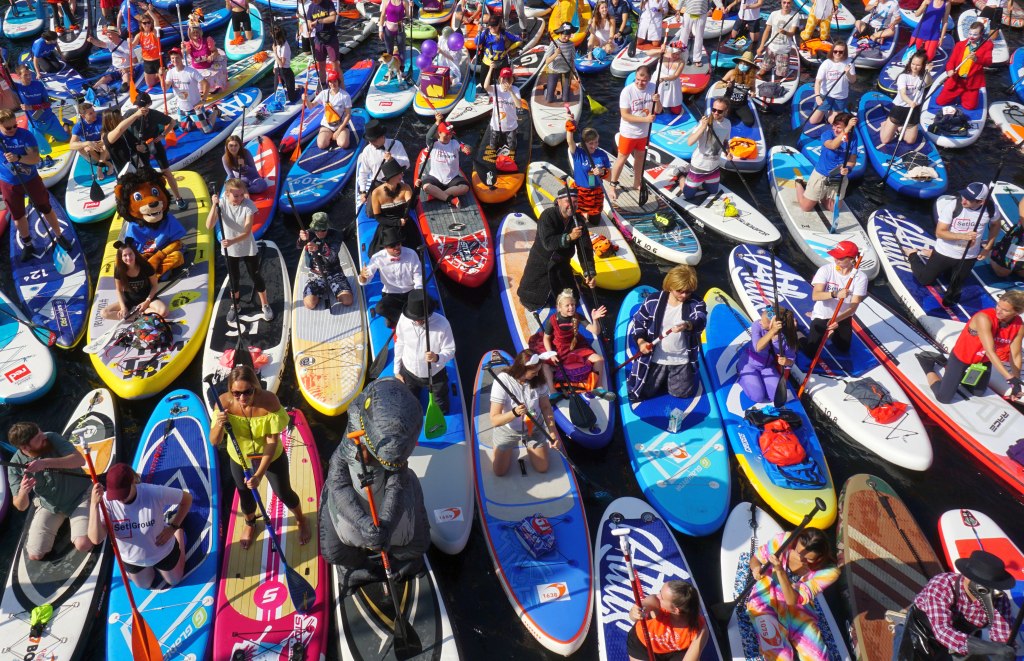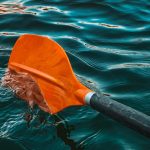Think of buying a stand up paddle board? Below we break down all aspects of SUP costs so you've got a clear idea of how much you can expect to spend.
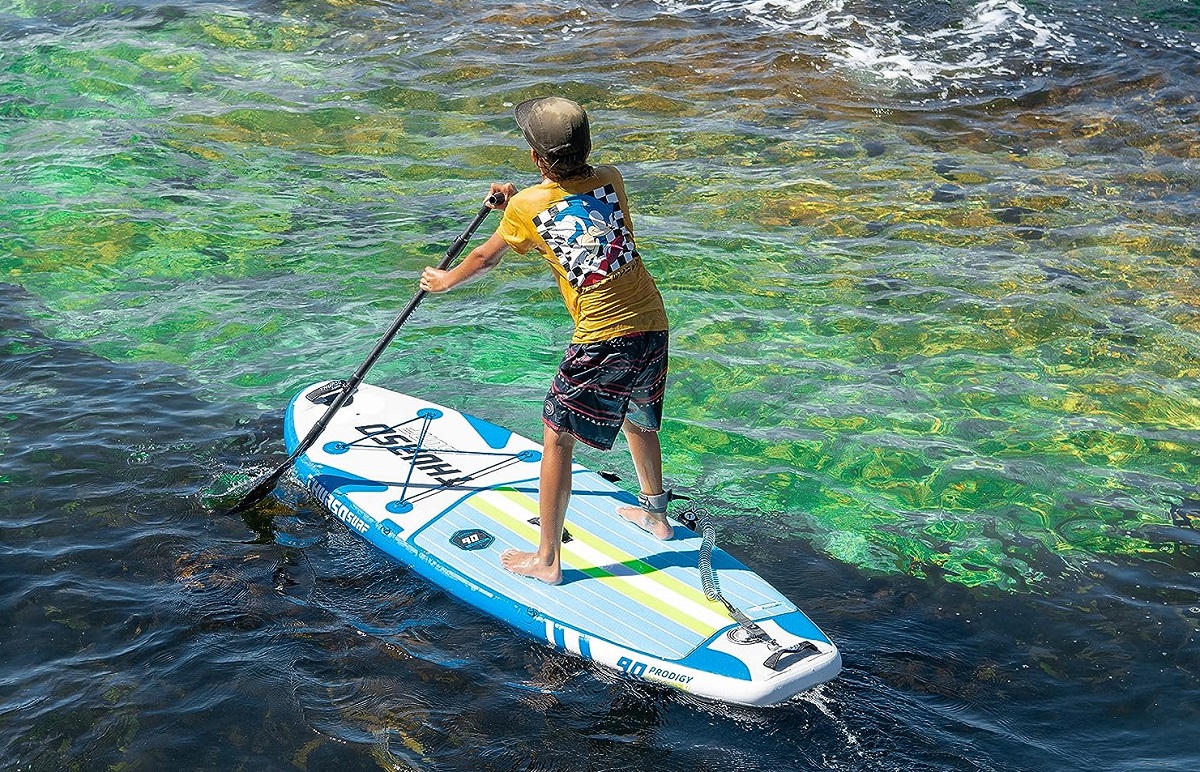
There’s nothing I love more than a good summer lake day with my whole family!
It’s not just me and my wife, but my four kids on the water beside me, all of us together in a “fleet” of paddleboards enjoying the sun, cool water, and glorious views.
When I first fell in love with paddleboarding, I knew it was a pastime I wanted to share with my kids. I spent a lot of time researching the best paddle boards for kids and teenagers so I could buy SUPs for all of us to take out on the water.
Thanks to my research (100+ hours, testing 20+ products, and reading thousands of product reviews), I’ve put together a list of the best paddle boards for kids, as well as a complete guide to help you know exactly which SUPs to choose for your kids of any age, size, or paddling skill level.
By the time you reach the end of this page, you’ll be ready to put together your own paddleboarding fleet!
As an affiliate of Amazon and other retailers, we may earn a small commission when you buy via our links, at no additional cost to you. Thank you!
At a Glance: Best Paddle Boards for Kids
Best Overall: Atoll Inflatable Paddle Board
Most Stable: iRocker Nautical Kids Inflatable Paddle Board
Best for Active Kids: Bluefin Stand Up Paddle Boards Cruise Jr 8′ Package
Best Full-Sized: Gili 10’6 AIR
Best for Young Teens: iRocker Cruiser Ultra 2.0
Best Hard-Shell: Starboard Go
Best for Smaller Kids: Honu Airlie 8’6
Best Premium: Red 9’4″ Snapper
Best Budget: THURSO SURF Prodigy Junior Kids Inflatable SUP
Comparison Table: Best Paddle Boards for Kids
| Model | Specs | Where To Buy |
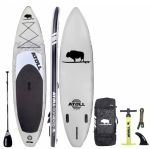 Atoll Inflatable Paddle Board | Size: 9’ x 30” Weight: 18 lbs. Weight Capacity: Unspecified | Atoll |
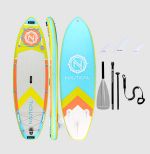 iRocker Nautical Kids Inflatable Paddle Board | Size: 9’ x 32” Weight: 17.2 lbs. Weight Capacity: 220 lbs. | iRocker |
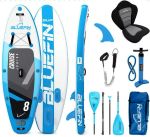 Bluefin Stand Up Paddle Boards Cruise Jr 8′ Package | Size: 8’ x 29.1” Weight: 22 lbs. Weight Capacity: 176 lbs. | Bluefin |
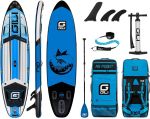 Gili 10’6 AIR | Size: 10’6” x 32” Weight: 19 lbs. Weight Capacity: 280 lbs | Amazon |
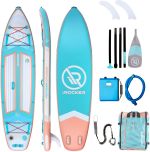 iRocker Cruiser Ultra 2.0 | Size: 10’6” x 33” Weight: 21 lbs. Weight Capacity: 300 lbs. | Amazon |
Starboard Go | Size: 10’2” x 29” Weight: 21 lbs. Weight Capacity: 210 lbs. | Starboard |
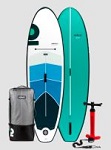 Honu Airlie 8’6 | Size: 8’6” x 27” Weight: 11.9 lbs. Weight Capacity: 154 lbs. | HONU |
 Red 9’4″ Snapper | Size: 9’4” x 27” Weight: 17 lbs. Weight Capacity: 132 lbs. | RED |
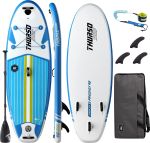 THURSO SURF Prodigy Junior Kids Inflatable SUP | Size: 7’6” x 30” Weight: 19 lbs. Weight Capacity: 165 lbs. | Amazon |
The 9 Best Paddle Boards for Kids
Best Overall: Atoll Inflatable Paddle Board
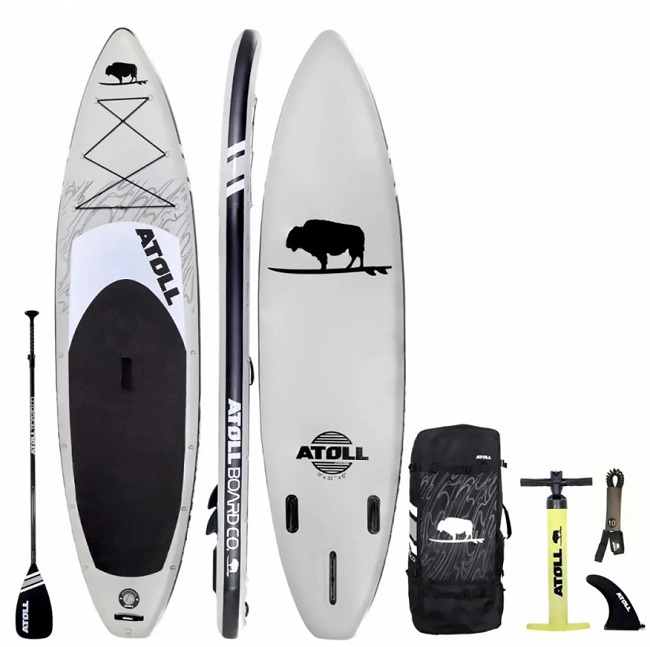
Length: 9’ (274.32 cm)
Width: 30” (76.2 cm)
Weight: 18 lbs. (8.16 kg)
Weight Capacity: Unspecified
This 9-footer board is the ideal size for kids, and it’s sturdy enough to last for years of regular use (and roughhousing!) without breaking down or wearing out. Made from machine-laminated dual-layer PVC, it’s the toughest of all kids-sized paddle boards.
Each board comes with 15 D-rings, enough to connect a ton of accessories (from coolers to seats to paddlekeepers) and has plenty of front storage space for your kids to pack their gear. The 10-inch composite fin is extra-long for better handling and greater stability, and the two built-in skegs make it easy for your kids to stay on course when paddling.
It’s wonderfully stable, and delivers a smooth, efficient ride. My kids were so happy learning on this model that when the time came to upgrade, they insisted I get them the full-sized (11’ 6”) version.
Most Stable: iRocker Nautical Kids Inflatable Paddle Board
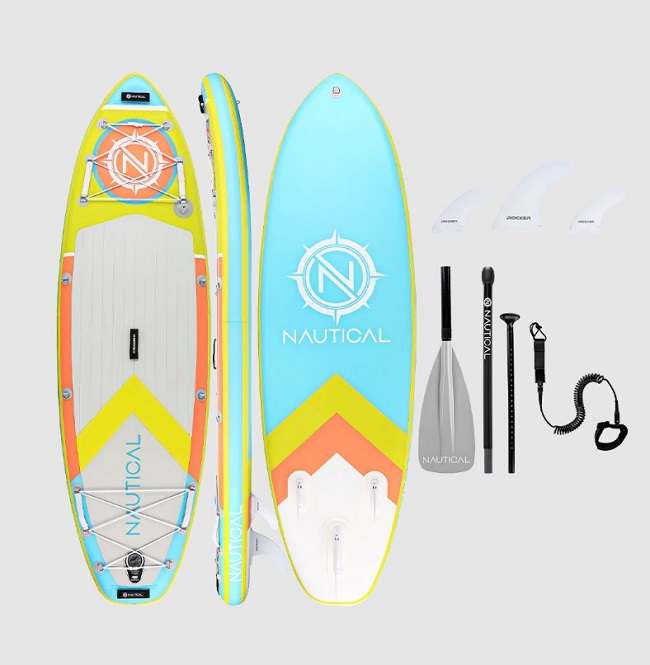
Length: 9’ (274.32 cm)
Width: 32” (81.28 cm)
Weight: 17.2 lbs. (7.8 kg)
Weight Capacity: 220 lbs. (99.79 kg)
Of all the SUPs my kids tested out, they rated this one as the most stable on flat, calm water. It doesn’t have the best secondary stability (not great for beach/ocean use), but for lakes and slow-moving rivers, it’s an excellent beginner board for kids who are just learning to stand up and maintain their balance.
The bright colors are always a popular choice with kids, as is the soft, well-cushioned ¾-length deck pad. The addition of not one but three nylon fins improves its stability and handling significantly. Storage-wise, it’s a game-changer, with both front and rear bungee cord rigging for your kids to stash a dry bag, cooler, water bottle, and pool toys.
The three-piece paddle delivers excellent performance, thanks to its fiberglass construction and nylon blade. Best of all, the carry bag can be upgraded from a standard backpack to a wheeled bag so your kids don’t have to struggle to haul it to and from your vehicle.
Best for Active Kids: Bluefin Stand Up Paddle Boards Cruise Jr 8′ Package
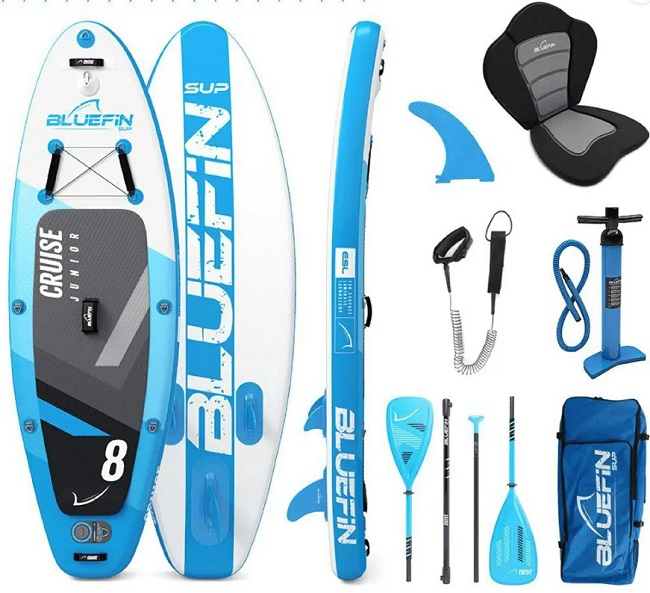
Length: 8’ (243.84 cm)
Width: 29.1” (73.9 cm)
Weight: 22 lbs. (9.98 kg)
Weight Capacity: 176 lbs. (79.83 kg)
If your kids want to enjoy both paddle boarding and kayaking, this is the option for them!
The SUP package comes with a seat included that lets you turn the paddle board into a kayak in a matter of seconds, or switch right back to SUP when your kids want to paddle standing up. The seat is comfortable and offers surprisingly good support thanks to the multiple straps, and the clips anchor it to the D-rings efficiently.
The board is built using drop-stitch technology and an “Exo Surface Laminate” technology that makes the material more resilient to UV damage. The heat-welded double side rails add extra stiffness and sturdiness to make a more solid platform for your kids to play around on and jump off of.
And thanks to the action camera mount, they can add on a GoPro to film their paddling adventures.
Best Full-Sized: Gili 10’6 AIR
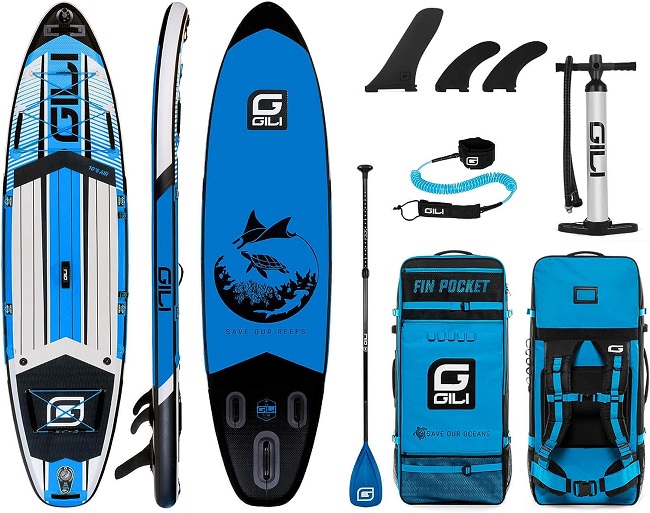
Length: 10’6” (320 cm)
Width: 32” (8.3 cm)
Weight: 19 lbs. (8.62 kg)
Weight Capacity: 280 lbs. (127 kg)
If you want a paddleboard that’s kid-friendly but large enough that they can grow into it and use it well into their teenage and adult years, the Gili 10’6 AIR is a great pick.
At just 19 pounds, it’s light enough that older kids can carry it to and from the water with ease, but its 280-pound weight capacity ensures they can keep using it even as they grow.
The front and rear bungee cord rigging offers plenty of storage space, and the multiple D-rings set around the board’s perimeter can accommodate a seat, cooler, and other accessories. Thanks to the extra-large traction pad, you can do SUP Yoga, take a nap, or bring a furry friend onboard and paddle in comfort.
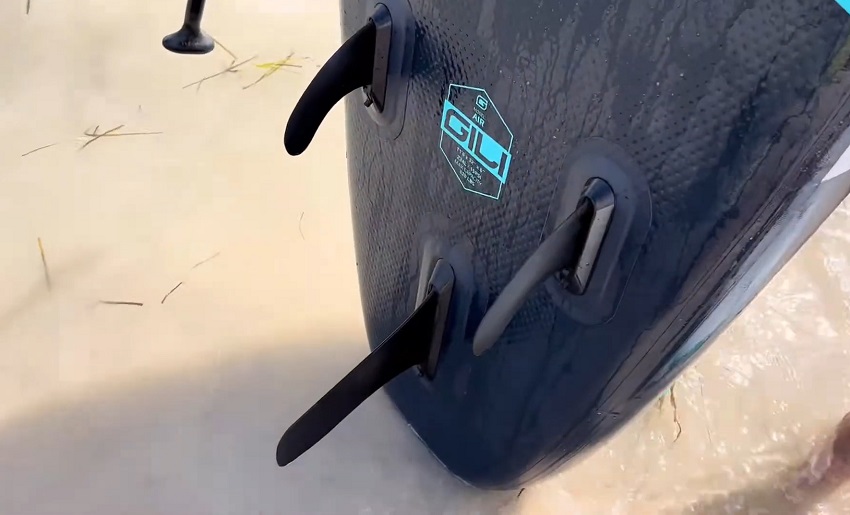
Tracking and handling is all made excellent thanks to the three detachable fins (all 9” long), and the board’s 32” width gives it enough primary stability to be solid on calm water but maintain its balance when out on the ocean.
Best of all, it’s an affordable option but is still backed by a 2-year warranty to guarantee its quality.
Best for Young Teens: iRocker Cruiser Ultra 2.0
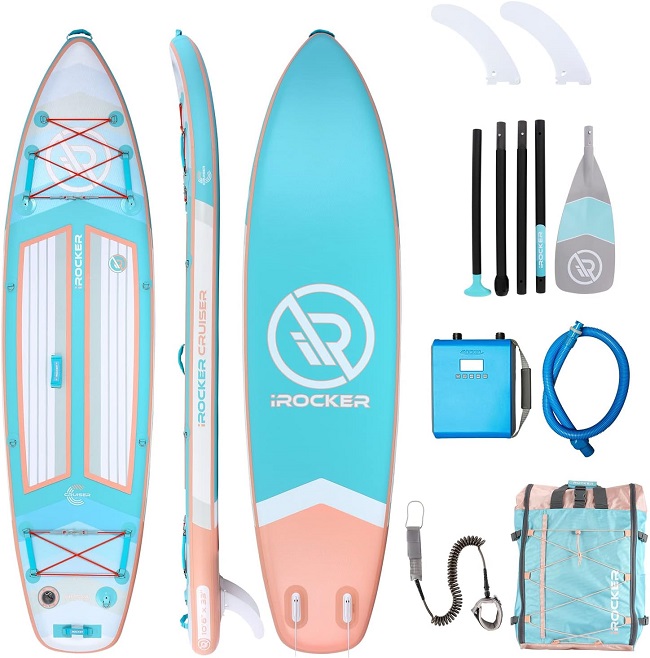
Length: 10’6” (320 cm)
Width: 33” (83.8 cm)
Weight: 21 lbs. (9.53 kg)
Weight Capacity: 300 lbs. (136 kg)
For parents of young teens who are getting into paddle boarding and want an SUP that will last them into their adult years, the iRocker Cruiser Ultra 2.0 is an excellent choice. Light but sturdy, it offers excellent handling and tracking as well as a good balance between primary and secondary stability.
The board is on the shorter side for an adult-sized board, which makes it perfect for nearly-grown teenagers. The 33” width keeps it from being tippy so even newbies can master the balance with ease. The deck pad is a bit too short for very tall teenagers, but anyone under 5’8” will find it’s more than suitable.
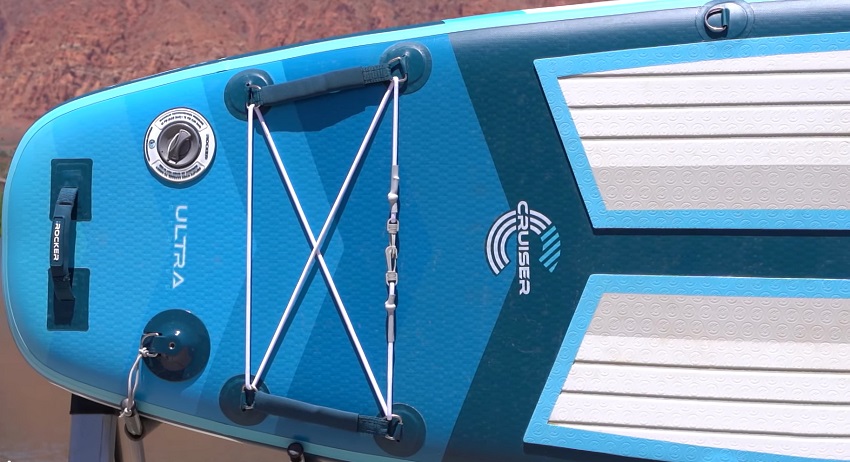
Best of all, the board comes with a 12V electric pump included (in its own separate accessory bag) so you never have to worry about pumping up the SUP by hand ever again.
Best Hard-Shell: Starboard Go

Length: 10’2” (310 cm)
Width: 29” (73.66 cm)
Weight: 21 lbs. (9.53 kg)
Weight Capacity: 210 lbs. (95.25 kg)
The Starboard Go is built for newbie paddlers, but it’s sleek, speedy, and versatile enough to keep up with your kids as they develop paddling skills. Its classic surfboard-style shape gives it both speed and good secondary stability so your kids can take it out on choppy water and ride the waves. But when it comes to calm, flat water, the primary stability is good enough to enable even first-timers to maintain their balance with ease.
The deep center channel on the board’s hull creates a flatter middle rocker that not only improves stability, but also improves tracking and keeps the board gliding through the water in as straight a line as possible. The bottom side plane adds good primary stability but keeps the board just tippy enough it can handle swells and surf.
One very cool feature: the board features a center fin box so you can switch it from the rear (standard placement on an SUP) to the center for SUP windsurfing. Talk about versatility!
Best for Smaller Kids: Honu Airlie 8’6
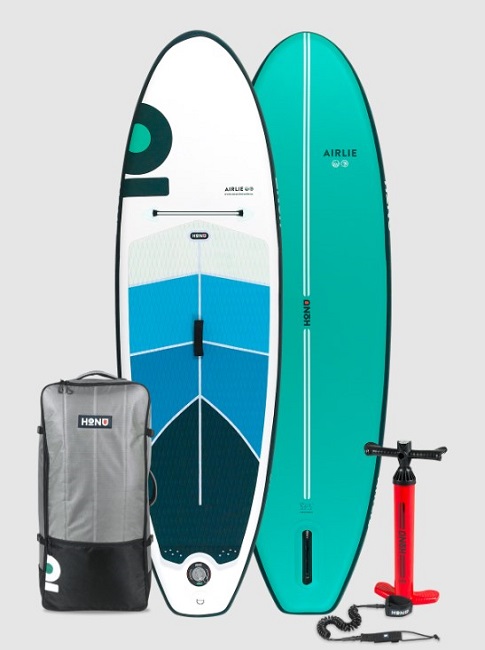
Length: 8’6” (259 cm)
Width: 27” (68.58 cm)
Weight: 11.9 lbs. (5.4 kg)
Weight Capacity: 154 lbs. (69.85 kg)
For kids ages 5 to 12, Honu’s Airlie is the way to go. At just eight-and-a-half feet long and 27 inches wide, it’s short and narrow enough for young kids to handle with ease. It’s also nicely lightweight—just under 12 pounds—so there’s no struggle to get it to and from the water.
The inflatable SUP is made using X-Woven & fused drop stitch PVC, with triple-bonded rails that create a sturdy, stable platform. Active kids will love using it as a diving board or swimming platform.
The board is best-suited to flat, calm water or very small waves, and a great option for any kids who are headed out for their first paddling trips. Though a bit on the pricier side, it’s an excellent investment for parents with large families, as the board is tough enough to pass down from one kid to the next for years to come.
Best Premium: Red 9’4″ Snapper

Length: 9’4” (284.48 cm)
Width: 27” (68.58 cm)
Weight: 17 lbs. (7.71 kg)
Weight Capacity: 132 lbs. (59.87 kg)
Red Equipment has made a name for itself as being one of the best SUP manufacturers, turning out high-quality, long-lasting premium products—with the price tag to match.
Despite being the most expensive board on our list, it’s the toughest and most reliable. The fins are the brand’s signature “indestructible” iFins, and the board is crafted using high-grade Monocoque Structural Laminate (MSL) that combines drop-stitch technology with layers of laminated fabric coated with high-resilience finishes. The end product is insanely durable, capable of withstanding the rough-and-tumble use it can expect from kids of all ages.
Thanks to its shorter length (9’4”) and narrower (27”), thinner (4”) construction, the board is speedy and responsive, beautifully easy to maneuver through tight creeks or ocean swells. The lower center-of-gravity also improves stability, making it suitable for both SUP surfing and paddleboarding.
Parents of active kids will love the fact that this board is backed by a 5-year warranty to “be free of defects in material or workmanship”. You can spend a bit more knowing it’ll hold up to anything your kids can throw at it.
Best Budget: THURSO SURF Prodigy Junior Kids Inflatable SUP
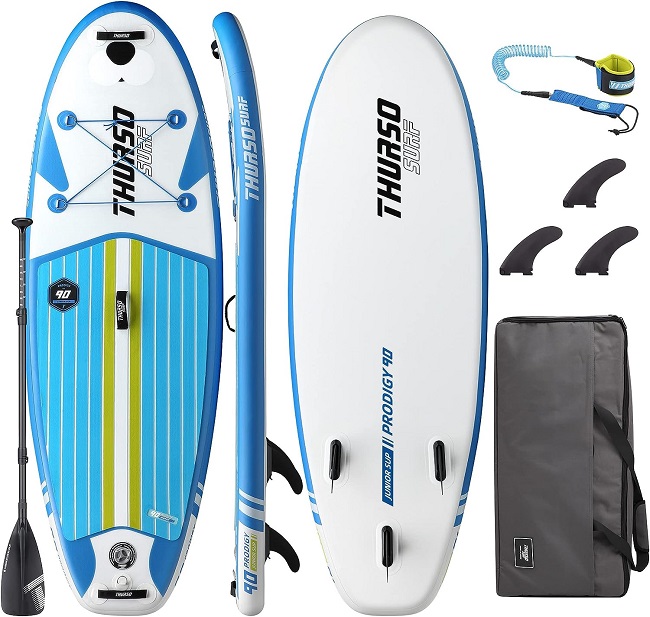
Length: 7’6” (228.6 cm)
Width: 30” (76.2 cm)
Weight: 19 lbs. (8.62 kg)
Weight Capacity: 165 lbs. (74.84 kg)
Looking to keep the cost of your kids’ first paddleboard low? The THURSO SURF Prodigy Junior Kids Inflatable SUP is just the budget-friendly option you should consider.
At 7’6”, it’s the shortest SUP on our list, perfect for young kids who are looking to get out on the water and experience paddle boarding for the first time. Though not the speediest, the 30-inch width makes it stable enough for newbies to master the balance and handles nicely on lakes, rivers, and even coastal waters.
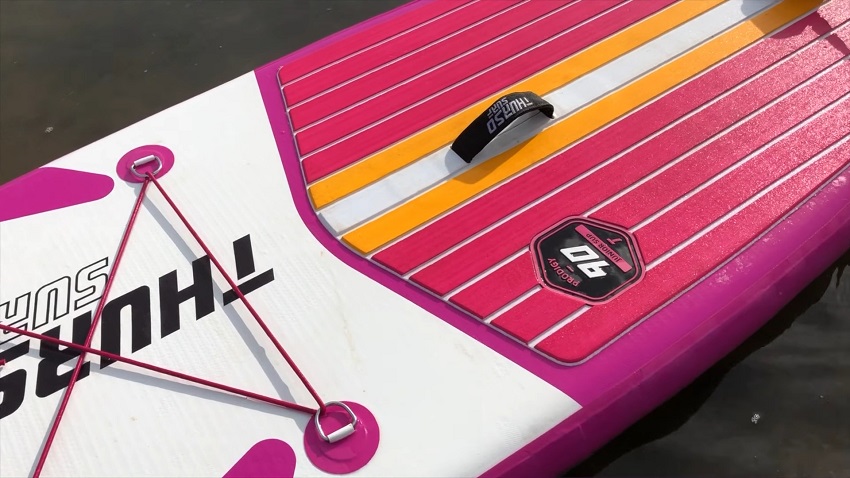
The double-layer construction with triple and quad military-grade PVC material is sturdy enough to stand up to very active children, and the drop-stitch core makes it an even more solid SUP (if a bit heavier).
The three removable fins let you customize how you want the board to handle, and improves its tracking and maneuverability nicely.
Backed by a 2-year warranty, it’s an affordable investment you’ll be happy to make.
A Guide to Buying Paddle Boards for Kids: Factors to Consider
Length
Typically, kids’ paddle boards tend to be shorter than adult paddle boards—usually in the 8 to 10-foot range.
Why is this? Well, for starters, being that kids are shorter and lighter, they don’t need such a high weight capacity (see “Weight Capacity” section below). Shorter boards are also more maneuverable and easier to steer. They’re also lighter and thus more portable—your kids can carry them to and from the water themselves without needing your help.
Width
While adult SUPs tend to be in the 32 to 36-inch range, you can find some kids’ paddleboards that are as narrow as 27 or 28 inches.
Narrow boards tend to be less stable (see the “Stability” section for an explanation as to why), but they’re typically easier to maneuver and better-suited for kids to handle.
Any SUP from 27 to 32 inches in width will usually be ideal for young kids, older kids, and even younger teenagers.
Thickness
The thickness of the board plays a significant role in both its stability and weight capacity. Given that kids’ SUPs don’t need to have such a high weight capacity (though stability is still important!), many paddle boards for kids will usually be 4 or 5 inches thick instead of the 6-inch thickness standard for adult SUPs.
These thinner boards may still be stable for kids, but they will have a significantly lower weight capacity.
Weight
Kids need to be able to carry their own SUPs to and from the water. For older kids and younger teenagers, a 20-pound adult-sized paddle board might not be too bad, but there’s no way younger children will have that kind of strength.
Which is why most kids’ paddle boards tend to be noticeably lighter than adult SUPs. You can find some as light as 10 to 12 pounds, though many will be around 15 pounds (including the paddle and accessories). That’s definitely light enough for your kid to haul a few hundred yards from the parking lot across the beach, lakeshore, or down to the riverbank.
Weight Capacity
The “average body weight” in North America is around 180 lbs. for a grown adult, while the average 10-year old weighs around 70 pounds.
No surprise, then, that paddle boards for kids will usually have a lower weight capacity.
The weight capacity of inflatable SUPs is determined by the amount of air (volume) the board can hold. The higher the volume, the higher the weight capacity.
Longer, wider, and thicker boards have more space to fill with air, so a higher volume. Shorter, narrower, and thinner boards have less space to fill with air, so a lower volume. It’s basic physics, really.
Kids don’t need as high a weight capacity, which is why SUPs for kids can get away with being shorter (8 to 10 feet), narrower (26 to 30 inches), and thinner (4 to 5 inches).
However, bear in mind that as your child grows in size and weight, they may quickly outgrow their paddle board if it has a low weight capacity. By the time they’re a teenager, they may need to upgrade to a more adult-sized board as they put on the inches and pounds.
Material
Let’s be honest: kids are not gentle with their toys or sports equipment.
The first thing my sons did when they got the hang of paddling was paddle jousting (yes, that’s exactly what it sounds like!). And don’t get me started on how much they wrestled on and around their SUPs.
So when I considered buying them a paddleboard, the first thing I took into account was the material used in its construction, and the durability of the board overall.
Hard-shell SUPs tend to be the hardiest choice for kids. Rotomolded polyethylene (the same stuff used to build whitewater kayaks) can take a serious beating without scratching, scuffing, denting, or cracking. While there are fiberglass and carbon fiber SUPs, those are better-suited to sport-specific use (racing, touring, etc.) by adults who will take good care of them.
Inflatable SUPs are typically made using PVC, a material that’s tough enough to withstand hardcore use. Some inflatable SUPs use dual or triple-layered PVC or military-grade PVC, which adds resilience to the paddle boards. However, bear in mind that inflatable SUPs do have seams that can split or tear if your kids aren’t careful with them. Inflatable boards left out in the sun for days at a time (for example, when on a camping trip) may also degrade more quickly from UV radiation.
Handling and Tracking
The longer the board, the faster it typically is and the straighter it paddles. Shorter boards are more maneuverable, however, and can make sharper, tighter turns (for example, when navigating creeks or inlets).
Narrower and thinner boards will usually be easier to handle than wider, thicker boards. However, you lose a bit of primary stability (see the next section), making them less than ideal for beginner paddlers.
Stability
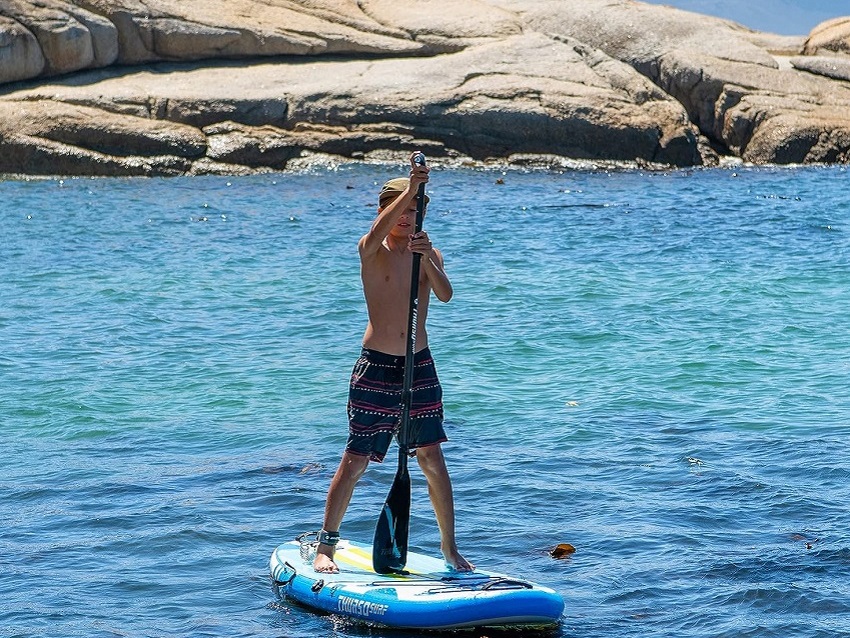
There are two types of stability to consider:
Primary stability, which refers to the SUP’s stability on flat, calm water. Typically, the longer, thicker, and wider the board, the higher its primary stability.
Secondary stability, which refers to the SUP’s stability on turbulent, choppy water. Essentially, the ability for the board to tip from side to side without flipping over. Typically, narrower, thinner boards have better secondary stability.
Which you prioritize depends a great deal on A) the location you plan to paddle, and B) the skill level of your kids.
If you’re going to paddle in (mostly) calm lakes, slow-moving rivers, and coastal inlets with only minimal tides and currents, primary stability should be your priority. Primary stability is also important if you’re going SUP fishing or want your kids to do SUP Yoga with you.
However, if you’re going to be paddling fast-moving rivers, or in the ocean where there are waves, swells, and strong currents, secondary stability becomes a more important factor to consider. Secondary stability is also important for touring, racing, and surfing SUPs.
Newbies will want a board that keeps them stable even on flat water, especially as they’re mastering the basics of balancing and paddling when standing upright. However, more experienced paddlers may find that higher secondary stability allows them to tackle choppier waters and rougher conditions, giving them greater versatility in where they use their paddle boards.
Inflatable SUPs tend to prioritize primary stability, but you can find some with decent secondary stability. Hard-shell SUPs, on the other hand, come in a wider range of designs, with many that place a higher emphasis on secondary stability.
Consider your kids’ skill levels and your paddling destination when thinking about your desired primary and secondary stability.
Storage
When talking about SUPs, “storage” typically refers to bungee cord rigging on the front and rear of the paddle board, which provides space to secure a dry bag, some gear, etc.
Longer paddle boards usually have more deck space, which means more space for storage. Shorter boards (such as kids’ boards) won’t usually have enough space for a significant amount of storage.
Why does this matter? Well, if your kids are just zipping around the lake for a few hours, they don’t really need much storage space. However, if you’re planning on paddling your SUPs loaded down with gear for camping, fishing, or even hunting (yes, SUP hunting is a real thing!), you’ll need extra storage space (not to mention additional weight capacity).
If you need more storage, you may want to consider upgrading to a small adult-sized board (10’ or 10’6”), which will have deck space for bungee cord rigging.
Comfort
Comfort usually comes in the form of a soft deck pad that A) provides them good traction/grip on the deck of the board when wet, and B) provides a cushioned surface for them to fall on.
If your kids like to roughhouse or are still unsteady and working on mastering their balance, a deck pad can do wonders to keep them from getting injured on their SUP.
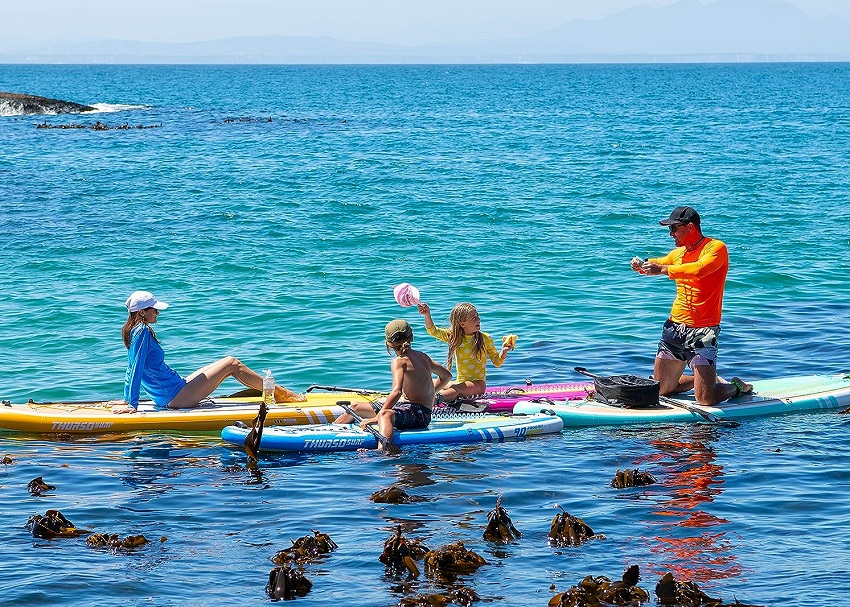
Accessories
There are a few accessories that will make the paddling experience much more enjoyable for your kids:
- Paddle – Specifically, a paddle sized to them. Typically, kids’ paddles will be shorter, lighter, and easier to maneuver than adult paddles, though not quite as speedy.
- Fins/Skegs – SUPs need at least one fin to not only improve handling/tracking, but also provide stability. The fins thrust straight down into the water (anywhere from 4 to 9 inches) and create water resistance to keep the board from tipping from side to side. Boards with 2-3 fins tend to be more stable and paddle straighter. Skegs (smaller built-in fins) will serve as a replacement for extra fins, but on their own, won’t create enough water resistance to provide stability.
- Paddlekeeper – This is a very handy accessory for kids who like to play around or jump on/off their SUP to get in the water. Having somewhere to secure the paddle keeps them from losing or forgetting it while they’re playing around.
- D-rings – Multiple D-rings placed around the perimeter of the SUP deck will provide convenient lashing points for a SUP seat, a cooler, paddlekeeper, or other accessories.
- Mounts – If your kids want to film their paddling, action mounts will provide them a place to attack a GoPro. Or, if you’re going fishing, you can mount a fishing rod holder. Not all SUPs come with these extra mounts, but they’re very handy if you are looking to do more with your paddle board.
Price
Face it: kids are rough on their toys and may not take as good care of them as you or I would. Which means that any SUP you buy for your kids runs a very real risk of breaking or being damaged.
It’s not wise to invest too much into an SUP for kids, given that A) they’ll likely break it, and B) they’re almost certain to outgrow it in a few years.
Thankfully, there are a lot of budget-friendly SUPs for kids that will be a smart, wallet-friendly investment to get them out on the water today.
Spend anywhere from $250 to $400 on an SUP for kids who are brand new to paddling. For more experienced paddlers, consider going as high as $600 to $900 (for a higher-end touring, racing, or surfing SUP).
Paddle Boards for Kids FAQs
Kids can start paddling at pretty much any age they feel comfortable out on the water (with a lifejacket) and can paddle the SUP. It’s common to see kids as young as 4 or 5 zipping around on kid-sized paddle boards.
Kids will be better-served with a shorter, narrower, and thinner board that is lighter and easier to maneuver. Given how light they are, they don’t need such a high weight capacity, and they tend to pick up the balance aspect of paddleboarding fairly quickly.
Inflatable paddle boards are actually easier to stand on because of their higher primary stability (due to the air filling the SUP). Modern SUPs are built using materials that provide sufficient stiffness to feel like they’re as “solid” as hard-shell SUPs.
Absolutely! A 10’ SUP should have a high enough weight capacity and sufficient deck space for two (even three) kids, or two young adults.







